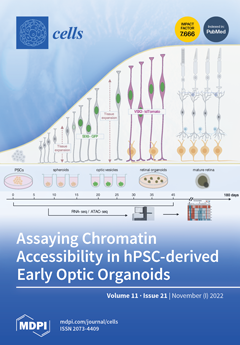A few prior animal studies have suggested the transplantation or protective effects of mesenchymal stem cells (MSCs) in noise-induced hearing loss. This study intended to evaluate the fates of administered MSCs in the inner ears and the otoprotective effects of MSCs in the noise-induced hearing loss of rats. Human embryonic stem cell-derived MSCs (ES-MSCs) were systematically administered via the tail vein in adult rats. Eight-week-old Sprague-Dawley rats were randomly allocated to the control (
n = 8), ES-MSC (
n = 4), noise (
n = 8), and ES-MSC+noise (
n = 10) groups. In ES-MSC and ES-MSC+noise rats, 5 × 10
5 ES-MSCs were injected via the tail vein. In noise and ES-MSC+noise rats, broadband noise with 115 dB SPL was exposed for 3 h daily for 5 days. The hearing levels were measured using auditory brainstem response (ABR) at 4, 8, 16, and 32 kHz. Cochlear histology was examined using H&E staining and cochlear whole mount immunofluorescence. The presence of human DNA was examined using
Sry PCR, and the presence of human cytoplasmic protein was examined using STEM121 immunofluorescence staining. The protein expression levels of heat shock protein 70 (HSP70), apoptosis-inducing factor (AIF), poly (ADP-ribose) (PAR), PAR polymerase (PARP), caspase 3, and cleaved caspase 3 were estimated. The ES-MSC rats did not show changes in ABR thresholds following the administration of ES-MSCs. The ES-MSC+ noise rats demonstrated lower ABR thresholds at 4, 8, and 16 kHz than the noise rats. Cochlear spiral ganglial cells and outer hair cells were more preserved in the ES-MSC+ noise rats than in the noise rats. The
Sry PCR bands were highly detected in lung tissue and less in cochlear tissue of ES-MSC+noise rats. Only a few STEM121-positivities were observed in the spiral ganglial cell area of ES-MSC and ES-MSC+noise rats. The protein levels of AIF, PAR, PARP, caspase 3, and cleaved caspase 3 were lower in the ES-MSC+noise rats than in the noise rats. The systemic injection of ES-MSCs preserved hearing levels and attenuated parthanatos and apoptosis in rats with noise-induced hearing loss. In addition, a tiny number of transplanted ES-MSCs were observed in the spiral ganglial areas.
Full article






